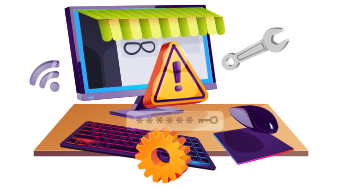Regular Shopify maintenance is important for a number of reasons. Here is why businesses must consider it.
How Does Regular Shopify Maintenance Impacts Brand Reputation?
So, you are done with building your Shopify store? Congratulations! Now you must be thinking of gaining the required traction and visibility, and keeping this visibility for long term, right? If yes, Shopify maintenance services can help you in this concern.
Shopify as an eCommerce platform is exceptional for considering it as your online store. While managing the online store is an entirely different process, getting regular maintenance can help scale the business.
Maintenance to a Shopify store includes several processes. The article will explain how a Shopify development agency offers these services.
Stages of Daily Shopify Maintenance
For everyday Shopify maintenance, some key operations are required continuously.
-
Managing Website Content
Key considerations to focus when choosing Shopify store maintenance mode.
Up-to-date Product Catalogue
Your product descriptions and pricing should be refreshed regularly to keep up with the latest trends, supplier prices, and competition. This ensures your customers are well-informed and more likely to make a purchase. By staying updated, you can provide accurate information and stay competitive in the market.
Engaging Visual Appeal
It’s important to not only update your banners and images regularly but also try new formats and layouts. To ensure that your updates are engaging and representative of your brand values, consider doing A/B testing to see which layouts and formats are most effective in driving engagement and conversions. This also makes your consumers engaged and gather valuable data to inform future updates.
Optimise Your Website for SEO
Enhance your website content for SEO and create ad targeting content that resonates with your audience. Optimize your product descriptions, titles, meta descriptions, website structure, URL structure, and alt tags for images. Use psychological tactics to craft ad targeting content that connects with customers and identifies your brand. Improve your search rankings, drive traffic, and increase conversions.
- Managing Orders
Managing orders is the next crucial step. From receiving and processing orders to tracking shipments and handling returns, each step of the order management process requires meticulous attention to detail and seamless coordination. Now, let’s explore what needs to be done for Shopify store maintenance mode:
Checking for New Orders
As a merchant, it’s crucial to regularly check for new orders on your Shopify store. This practice helps you stay updated on your sales, prevent potential errors or delays in order processing, and ensure timely fulfillment of customer orders. Regular Shopify maintenance services would ensure new orders are kept checked.
Updating Order Statuses and Tracking Information
After processing an order, it’s essential to update its status and provide tracking information to customers. This proactive approach keeps customers informed about their order status and expected delivery date, enhancing their overall shopping experience.
Managing Cancellations, Refunds, and Returns
Customers may occasionally need to cancel an order, return an item, or request a refund. Efficient order management involves promptly handling such requests with clear and concise communication to build trust and loyalty with customers.
Managing Transactions
Effective transaction management includes securely processing and verifying payments, among other transaction-related processes. This helps prevent fraud, minimize stockouts, and reduce errors in order processing, ultimately improving the overall customer experience and ensuring the security of your store.
-
Managing Inventory
Managing inventory needs you to ensure close attention on right coordination at every level. It also includes refilling stock, and deleting out-of-stock products. Here is more on the aspects that must be kept into consideration:
Checking Inventory Levels
Regularly checking inventory levels is a vital aspect of inventory management in Shopify. It allows you to monitor which products are running low and need restocking. By keeping an eye on inventory levels, businesses can gain insights into what products are selling well and which ones aren’t, helping merchants make informed decisions about their stock.
Restocking Products
Promptly restocking products is crucial to avoid running out of stock and losing potential sales. Shopify’s inventory management software can streamline this process by providing real-time inventory updates and sending automatic restocking alerts, ensuring your store is always well-stocked.
Managing Discontinued Products
Effectively handling discontinued products is essential for maintaining a positive user experience and avoiding SEO issues. When a customer encounters an out-of-stock product, it can lead to confusion and frustration, increasing the bounce rate. To prevent this, businesses should remove discontinued products and either redirect customers to similar items or suggest alternatives, ensuring a smooth shopping experience.
-
Managing Customer Queries
Managing customer queries is one of the most important aspects of keeping your business connected to the audiences. This is also an essential part of Shopify maintenance services. From customers pre-purchase concerns to addressing queries about orders and products, this phase includes answering all customers questions. Let’s look at what else matters:
Keeping Customer Data Organized and Secure
Customer data encompasses personal information such as names, addresses, contact details, and payment information. Ensuring this data is both organized and secure is crucial for maintaining customer privacy and preventing data breaches. Utilizing trustworthy apps and carefully reviewing the permissions they request during installation helps you understand how customer data is being used and protects it from misuse.
Responding to Customer Inquiries, Feedback, and Complaints
Promptly addressing customer inquiries, feedback, and complaints is essential for maintaining strong customer relationships. This process involves:
– Actively listening to customer concerns.
– Empathizing with their situation.
– Providing a resolution or explanation within a reasonable time frame.
– Following up to ensure customer satisfaction after the issue is resolved.
By handling customer interactions effectively, you can build trust and loyalty, enhancing the overall customer experience.
-
Store Performance Monitoring
This step includes monitoring Shopify store on a regular basis. It also involves checking store performance regularly. This helps to know if the store is working optimally. Regular monitoring also ensures security from various vulnerabilities for the store owners. Following are the extended considerations to keep an eye on:
Checking Store Speed and Load Times
A store’s speed and load times play a crucial role in user experience and search engine rankings. Regularly monitoring these factors involves checking how quickly your website loads and identifying any potential bottlenecks that could slow it down. Utilizing website speed testing tools can help you pinpoint issues and optimize performance, ensuring a smooth and efficient shopping experience for your customers.
Monitoring Traffic and Sales Data for Data-Driven Decisions
Analysing store traffic, user behavior, and sales data is essential for understanding how customers interact with your website. This information helps identify problem areas and refine marketing strategies to boost revenue and conversion rates. By leveraging website analytics tools, you can gather valuable insights to enhance your site’s performance, improve the user experience, and increase sales. This data-driven approach enables businesses to make informed decisions and stay competitive in the market.
The Bottom Line
Running a successful Shopify store is akin to being a master gardener. Cultivating and maintaining a thriving digital ecosystem requires patience and a keen eye for detail.
Maintaining a Shopify store goes beyond simply checking off tasks on a to-do list. It demands dedication and hard work to achieve long-term success. Embracing new technologies and techniques, and being willing to pivot when necessary, is essential to staying ahead of the competition. For quality maintenance, you can seek out reliable Shopify maintenance services, keeping in mind that costs may vary depending on the provider you choose.












